Waste water traps
All water using appliances and fittings within a house must have a water trap in the waste pipe to provide a water seal to the drains or atmosphere, this prevents smells, bacteria and insects entering the property.
Most modern waste plumbing (apart from W.C.s) use either 32mm (1.25 inch) (for hand basins) or 40mm (1.5 inch) (for sinks, baths, showers, dishwashers, washing machines) plastic pipe and fittings (including traps).
Pipe runs over 2m (6 feet) may use 50mm (2 inch) diameter pipe to avoid syphon effect when the waste is used.
The sizes quoted are the internal pipe sizes (and also the waste outlet from the sink/basin/bath etc), the outer diameter of the pipework does vary between different manufacturers thus pipes and fitting may not be interchangeable.

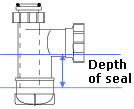 An important aspect of waste water traps is the depth of seal (see right).
An important aspect of waste water traps is the depth of seal (see right).
The current regulations require that where waste pipes discharge into a single stack (as is the current 'new build' requirement), the depth of seal must be at least 75mm (3 inches).
Where a bath or basin is being changed in an older property where the existing wastes feed into an open hopper or drain gully, the depth of seal may be 50mm (2 inches).
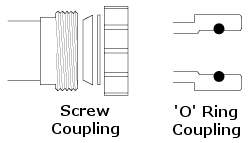 Typically the waste pipe fits to the trap by either a screw coupling (with a compression seal ring) or a push fit 'O' ring coupling - there's not much to choose between the two types.
Typically the waste pipe fits to the trap by either a screw coupling (with a compression seal ring) or a push fit 'O' ring coupling - there's not much to choose between the two types.
Here we show the common types of trap which may be found.
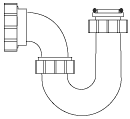 The 'P' trap - normally with a screw joint half way along so that:
The 'P' trap - normally with a screw joint half way along so that:
- The trap can be easily removed without disturbing the pipework when it is necessary to remove a blockage.
- The outlet can be adjusted through something like 270° in the horizontal plane to accommodate the position of the horizontal waste pipe connected to it.
A disadvantage of the 'P' trap is that it requires a fair amount of room around the waste outlet.
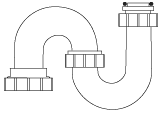 The 'S' trap - normally with a screw joint half way along so that:
The 'S' trap - normally with a screw joint half way along so that:
- The trap can be easily removed without disturbing the pipework when it is necessary to remove a blockage.
- The outlet can be adjusted through something like 270° in the horizontal plane to accommodate the position of the vertical waste pipe connected to it.
Like the 'P' trap, the 'S' also requires a fair amount of room around the waste outlet.
 The 'Bottle' trap, access to clean the trap is by unscrewing the bottom.
The 'Bottle' trap, access to clean the trap is by unscrewing the bottom.
The waste pipe is always fitted horizontally.
The 'Bottle' trap takes up less space under a waste outlet and is ideal for pedestal mounted basins where space is usually very limited.
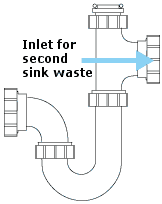 Various 'special' traps are available for some applications, such as:
Various 'special' traps are available for some applications, such as:
- Twin bowl sinks (as illustrated right);
- Washing machines;
- Dish washing machines.
Each has at least one additional inlet to reduce the plumbing pipework and connections.
 The 'Shallow' trap normally fitted to baths and showers where there is limited space.
The 'Shallow' trap normally fitted to baths and showers where there is limited space.
Where fitted to a bath, a banjo connector is normally fitted above it for the bath overflow.
Note that these traps may contravene water regulations in some areas as the water seal is less than required. To overcome this, another (deeper) trap may need to be inserted further along the pipe run where space allows.

![]() The 'Shallow' trap with a connector for the bath overflow.
The 'Shallow' trap with a connector for the bath overflow.
Normally these traps are supplied with a blanking plug fitted in the secondary inlet and a separate connector must be purchased and fitted to accept the hose from the bath overflow. This replaces the banjo connector which would otherwise be required and so these traps will fit where space is limited.
Again, note that these traps may contravene water regulations in some areas as the water seal is less than required. To overcome this, another (deeper) trap may need to be inserted further along the pipe run where space allows.
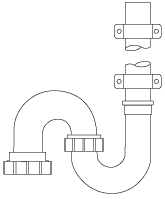
The Washing Machine 'S' trap incorporates a vertical standpipe into which the washing machine waste pipe is inserted.
The installation instructions for individual Washing Machine will specify the required height (normally an minimum and maximum) for the standpipe.
The Washing Machine 'P' trap is similar to the 'S' trap but the outlet suits a horizontal waste pipe.
